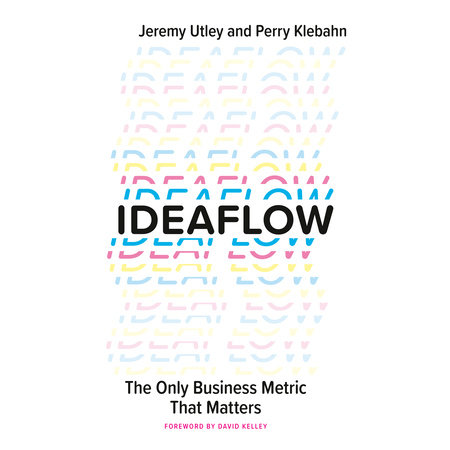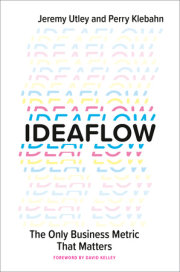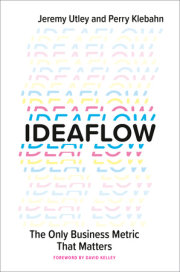Chapter 1: Measure Tomorrow's Success in Today's Ideas One resists the invasion of armies; one does not resist the invasion of ideas. -Victor Hugo
It was a chilly April morning in Ventura, California, when Perry realized he'd run out of ideas.
Getting out of his car at Patagonia headquarters, fleece pullover zipped to the chin and piping hot coffee in hand, Perry felt large and in charge. The year was 2002, and he was responsible for a good chunk of sales and operations at the beloved outdoor clothing company founded by iconoclast climber and blacksmith Yvon Chouinard. It had been an incredibly stressful few months for the entire world since the tragic events of September 11, but at least here and now, things were starting to feel normal again. Perry was lucky enough to work at a great company with outstanding values, and his colleagues were terrific. That morning, it felt OK to breathe deeply of the salty ocean air and welcome spring.
Perry's feeling of optimism cooled faster than his coffee, however, as he thumbed his way through the newly arrived racks of clothing for the following year's spring season. This funereal assortment would be sent to Patagonia's stores and countless other retailers around the country? These drab, colorless garments were Patagonia's idea of vernal exploration and renewal? Perry forced down a sip of now-lukewarm java.
Trying (and failing) to seem casual, Perry turned to the senior merchandiser busily organizing everything for the product team's review.
"Good morning, Adrienne," he said, forcing himself to breathe. "The product line looks a little . . . dark for a spring line, don't you think? Where are the new colorways?" There was an uncomfortable silence before she responded.
"New colorways?"
Perry smiled harder and inclined his head at the dispiriting racks of black and gray clothing as if to say, The colorways that aren't here yet, but must certainly be on the way. At that moment, Adrienne's face showed some of that missing color.
"Perry," she said, "you told us we have to focus on the winners."
Perry bit off a retort. It was true. He had said that. Somehow, playing it safe had made a lot of sense at the time. Now that Patagonia's spring lineup resembled a mortician's closet, however, not so much. Looking at rack after rack of black and gray clothing, he could just imagine the jarring effect these garments would have on Patagonia's bright and welcoming stores. Talk about a downer. This was the consequence of a decision that had been made, above all, to avoid risks. By narrowing his options in pursuit of "security," however, Perry had taken a terrible risk instead.
"How quickly do you think we can get some variety in here?" Perry asked, keeping that fake smile plastered to his face. "Things are getting back to normal. Customers are coming back to the stores. I think they'll be ready for a little color by next spring."
"You're kidding, right?" Adrienne replied, making no effort to match Perry's smile. "You know our standard lead time is eighteen months."
Eighteen months! Perry thought. How do I get today's ideas into yesterday's company so we still have a tomorrow? He dumped his cold, half-finished cup in a wastebasket. Time to get to work.
The dangerous business of new ideas As we've said, an idea is simply a new connection between two things that were already floating around in your head. When you give your brain a problem to solve, it goes to work, way in the background, by jamming disparate pieces of knowledge and experience together in different ways until a light bulb goes off. "Does this work?" Maybe, maybe not, but you don't want to cut off the flow of ideas yet, so you say: "Good job, brain! What else have you got?"
A problem, as we've said, is anything you don't already know how to do. It can be anything from "How do we meet next quarter's revenue target?" to "What colors should we offer for this season's snow pants?" The real-world effectiveness of any potential solution is unknown until it's tested, so every single idea represents a risk. Forget the possibility of catastrophic failure-in many cases, it simply won't work.
Thus, tackling an unfamiliar problem-or seeking out a better solution for a familiar one-requires not just ingenuity but courage and vulnerability. A willingness to put things out there and make the occasional mistake. The irony of the creative process is that we limit our creativity just when we need it the most, as illustrated by Perry's experience at Patagonia. When we're under pressure, we default to the known and familiar approach even when it clearly won't suffice. It feels safer to fail by doing the expected thing than risk looking foolish by trying something new.
Through the system in this book, you will unlearn this defensive instinct so that you can maintain a steady flow of new ideas through adverse circumstances. You must learn to trust in your ingenuity. If you can keep the pipeline of potential solutions flowing in both good times and bad, you can overcome any challenge. Abundant creativity and the capacity to execute on it represent an extraordinary competitive advantage. To understand why, let's go back to Patagonia.
There are tough times, and then there are catastrophes. After the tragic events of September 11, 2001, no one knew how to react. Beyond the sense of existential threat to the United States felt by many at the time, beyond the psychic shock of the unprovoked murder of thousands of civilians, the attacks disrupted everyday life for all Americans. Everything came to a halt. A sky without aircraft was just the most visible aspect of this collective paralysis. In the days and weeks after the fall of the Twin Towers, "normal" started to feel like a distant memory. People operated in a state of ceaseless vigilance. Who was responsible for the attacks? Would there be more? What would happen next?
Naturally, discretionary spending after the attacks sputtered. Businesses worldwide faced one hard choice after another. The slowdown might last years, especially if there were more attacks. How would they survive the next quarter, let alone meet their existing goals and targets? At Patagonia, Perry and the rest of the leadership team faced pressure to take decisive action. The company was on track to buy millions in raw materials for the upcoming season. Betting on the future seemed, well, risky, so, like nearly all their competitors that fall, Perry had cut the order for raw materials by a large percentage to match the drop in demand. As for where to make those cuts, he offered clear guidance to the merchandisers: "Keep the winners we know we can sell."
It doesn't require a wave of terrorist attacks to inspire short-term, self-defeating decision-making. Most of us try something new only when we're desperate. We weigh potential losses far more heavily than potential rewards. This so-called loss aversion exists for a good reason. If a prehistoric human mistook a bush for a lion, it was good for a laugh. Mistaking a lion for a bush, however, wasn't good for anyone but the lion. Deep-seated instinct tells us it's safer to stay the heck away from the bushes in general, even if some might hide tasty fruit. To attempt something new, you're fighting against the brain's bias. The problem when it comes to our ideas, however, is that we're terrible at distinguishing the winners from the losers until we've tried them. We will see many, many examples of this throughout the book. In our experience, the more experienced and successful the innovator, the less they trust their own capacity to pick the winners on sight. Never pick when you can test.
For an outdoor clothing company like Patagonia, black and gray basics are the "safe" options. When the creative team was told to pick the winners, that meant nothing new, nothing colorful. Dozens of new products under development were shelved. A rainbow of colorways was bleached away. At the time, this strategy made sense. What if people didn't want puce next spring because of the national climate of anxiety? Or what if they wanted puce, but not cerulean? Everyone can agree on black.
Can't they?
By the time the new spring line arrived for review, however, life in America was returning to normal. More important, many people were ready to pull on hiking boots and venture back into the outdoors to escape the doldrums of the new War on Terror. When these customers entered Patagonia's stores to outfit themselves for these much-needed excursions, however, they would encounter an array of options as dismal as the world they were trying to leave behind. Racks of black rain jackets as far as the eye could see. Nothing could have been further from the vibe of rebirth and renewal people would be seeking that spring. Patagonia's safe bet had proven to be anything but.
Realizing the extent of his overcorrection, Perry discovered that by turning off the designers' creative spigot-a decision that made perfect business sense in itself-he had left himself without options. He had no way to adapt to an unexpected situation. By narrowing the flow of the creative pipeline running from inspiration to ideas to experiments to products, Perry had ensured it would take a painfully long time to get a more vibrant array of clothes into stores. Of course, he had needed to take steps to protect the company in adverse circumstances, but, as we'll see, he could also have left himself options in anticipation of more than one possible turn of events. (If only he'd had this book at the time!) Luckily, while store traffic was low that spring, Patagonia was saved by the fact that its major competitors had fallen into the very same trap. Had Patagonia left themselves some options, they might have left those competitors in the dust.
As we'll discover, it's never safe to stopper the flow of new ideas entirely, regardless of outlook and external conditions. Pausing innovation for even a moment has a lasting effect. Since we weigh risks more heavily than rewards, discouraging creativity is effortless compared to encouraging it, which requires steady and patient work. You can't get ideas overnight. You need to keep them flowing in good times and bad. Ideas are solutions to future problems. They represent tomorrow's profits. No ideas, no tomorrow. That's why gauging the organization's capacity to innovate is the best way to measure success before it happens.
Every problem is an idea problem How creative are you? How creative is your team or organization? On the surface, this might seem like a Zen koan, an esoteric puzzle along the lines of "What is the sound of one hand clapping?" But creativity is concrete. When presented with a problem-whether it's "What should the product's tagline be?" or "How are we going to save next quarter?"-either you have new ideas or you don't. Good or bad doesn't enter into it yet. In most cases, you can't really judge the merit of an idea until you've tested it in the real world. At the start, you just need lots and lots of ideas. When it comes to creativity, quantity drives quality.
The most useful measure of creativity we've found is as follows: the number of novel ideas a person or group can generate around a given problem in a given amount of time. We call this metric ideaflow. An organization with low ideaflow is in trouble because it's running out of an essential resource. Its leaders know there's a problem, they can see that progress is stalling, but they can't quite pinpoint the scarcity starving it of its potential. While the proper execution of ideas is crucial, ideaflow is the foundation, the essential force that drives all future success.
You might wonder whether it's practical to pay so much attention to the raw generation of new ideas versus, for example, a more "bottom-line" metric like patents issued or new initiatives launched. The problem is, those lagging indicators tell you there's a problem long after you should have solved it. No measure is as useful as ideaflow at diagnosing innovation issues in time to address them. Tracking new products and services won't flag the flaws in your innovation process until it's too late. Think of that eighteen-month lead time at Patagonia. Also, results manifest in different ways. Some companies launch new products or services all the time: record companies, toy manufacturers, start-up incubators. Others-car companies, law firms, banks-continually refine a handful of core offerings. To get a clear and consistent sense of when creativity needs a boost, move upstream and observe the source.
Ideaflow is a useful proxy for measuring overall innovation capacity because the ability to generate a flood of ideas on demand correlates with overall creative health. It's a barometer-it doesn't tell you where every cloud is, but rather that a storm is on the way. When ideaflow dips, as when Perry's decision to "keep the winners" stifled contributions at Patagonia, it tells you there's a larger problem with your creative culture. For example, sensing the drop in ideaflow among the design team, Perry could have gone to them and asked them for new ideas on how to react to falling orders. Defaulting to an all-drab spring lineup was one approach, but there might have been many more to consider.
Ideaflow should be a key performance indicator on every leader's radar. Taking stock of personal and organizational ideaflow is a quick and easy way to determine a creative baseline and chart progress.
For many years, Amazon's profits bore little resemblance to the market cap of AMZN. Wall Street was betting on the future Jeff Bezos wanted to build. We'd argue that Amazon's stock price reflected the company's off-the-charts ideaflow. For a publicly traded company, that projected value took an unusually long time to manifest in its traditional business metrics. The earthshaking potential, however, was visible from the beginning in its extraordinary flood of ideas and its relentless commitment to experimentation. As always, the creative mindset of a company spreads from the top. Even before he founded Amazon, Bezos was "constantly recording ideas in a notebook he carried with him, as if they might float out of his mind if he didn't jot them down." He wasn't precious about these ideas, either. As a leader, Bezos "quickly abandoned old notions and embraced new ones when better options presented themselves." Modeling good creative habits yourself is the most effective way to cultivate and energize a creative team or organization. As CEO, Bezos modeled an approach that propagated throughout the company as its ambitions proliferated beyond selling books on the World Wide Web.
You might be thinking, the comparison doesn't work for me because disruption is expected in something like e-commerce. So, is your situation different because your industry isn't facing any disruption? If your business is somehow immune from the tidal forces affecting the rest of the world economy, tell us about it and you'll have our résumés in the morning.
Copyright © 2022 by Jeremy Utley. All rights reserved. No part of this excerpt may be reproduced or reprinted without permission in writing from the publisher.






